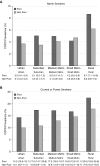Rural Residence and Poverty Are Independent Risk Factors for Chronic Obstructive Pulmonary Disease in the United States
- PMID: 30384774
- PMCID: PMC6467317
- DOI: 10.1164/rccm.201807-1374OC
Rural Residence and Poverty Are Independent Risk Factors for Chronic Obstructive Pulmonary Disease in the United States
Abstract
Rationale: In developing countries, poor and rural areas have a high burden of chronic obstructive pulmonary disease (COPD), and environmental pollutants and indoor burning of biomass have been implicated as potential causal exposures. Less is known about the prevalence of COPD in the United States with respect to urban-rural distribution, poverty, and factors that uniquely contribute to COPD among never-smokers.
Objectives: To understand the impact of urban-rural status, poverty, and other community factors on COPD prevalence nationwide and among never-smokers.
Methods: We studied a nationally representative sample of adults in the National Health Interview Survey 2012-2015, with data linkage between neighborhood data from the U.S. Census's American Community Survey and the National Center for Health Statistics Urban-Rural Classification Scheme. The main outcome was COPD prevalence.
Measurements and main results: The prevalence of COPD in poor, rural areas was almost twice that in the overall population (15.4% vs. 8.4%). In adjusted models, rural residence (odds ratio [OR], 1.23; P < 0.001) and census-level poverty (OR, 1.12; P = 0.012) were both associated with COPD prevalence, as were indicators of household wealth. Among never-smokers, rural residence was also associated with COPD (OR, 1.34; P < 0.001), as was neighborhood use of coal for heating (OR, 1.09; P < 0.001).
Conclusions: In a nationally representative sample, rural residence and poverty were risk factors for COPD, even among never-smokers. The use of coal for heating was also a risk factor for COPD among never-smokers. Future disparities research to elucidate contributors to COPD development in poor and rural areas, including assessments of heating sources and environmental pollutants, is needed.
Keywords: COPD; chronic obstructive pulmonary disease; epidemiology; health disparities; rural health.
Figures


Comment in
-
Socioeconomic Disparities and Health Outcomes.Am J Respir Crit Care Med. 2019 Mar 15;199(6):807-808. doi: 10.1164/rccm.201811-2073LE. Am J Respir Crit Care Med. 2019. PMID: 30580529 Free PMC article. No abstract available.
-
Reply to Chandrasekhar: Socioeconomic Disparities and Health Outcomes.Am J Respir Crit Care Med. 2019 Mar 15;199(6):808-809. doi: 10.1164/rccm.201811-2185LE. Am J Respir Crit Care Med. 2019. PMID: 30580532 Free PMC article. No abstract available.
-
Are Rural Residence and Poverty Independent Risk Factors for Chronic Obstructive Pulmonary Disease in the United States?Am J Respir Crit Care Med. 2019 Aug 15;200(4):519-520. doi: 10.1164/rccm.201904-0829LE. Am J Respir Crit Care Med. 2019. PMID: 31109173 Free PMC article. No abstract available.
-
Reply to Wei: Are Rural Residence and Poverty Independent Risk Factors for Chronic Obstructive Pulmonary Disease in the United States?Am J Respir Crit Care Med. 2019 Aug 15;200(4):520. doi: 10.1164/rccm.201905-0974LE. Am J Respir Crit Care Med. 2019. PMID: 31109175 Free PMC article. No abstract available.
References
-
- Kurmi OP, Semple S, Simkhada P, Smith WC, Ayres JG. COPD and chronic bronchitis risk of indoor air pollution from solid fuel: a systematic review and meta-analysis. Thorax. 2010;65:221–228. - PubMed
Publication types
MeSH terms
Grants and funding
LinkOut - more resources
Full Text Sources
Medical

